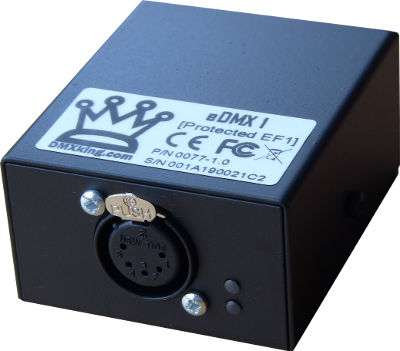We've launched our new site at www.openlighting.org. This wiki will remain and be updated with more technical information.
EDMX1
From wiki.openlighting.org
Link: http://dmxking.com/artnetsacn/edmx1
Made by: DMXKing
{{ #if: | ![]() }}{{ #if: yes |
}}{{ #if: yes | ![]() }}{{ #if: yes |
}}{{ #if: yes | ![]() }}{{ #if: yes |
}}{{ #if: yes | ![]() }}{{ #if: yes |
}}{{ #if: yes | ![]() }}{{ #if: yes |
}}{{ #if: yes | ![]() }}{{ #if: yes |
}}{{ #if: yes | ![]() }}{{ #if: |
}}{{ #if: | ![]() }}{{ #if: |
}}{{ #if: | ![]() }}
}}
Compact and robust this single universe Ethernet DMX512 node suits a wide range of applications. With power supplied via a USB mini-B socket many power source options exist since almost any USB port or USB charger/power supply will work just fine including USB ports on many wireless routers. You choose 3-pin or 5-pin XLR so no inline adapters required. Both DMX512 output and DMX512 input functions are supported along with E1.20 RDM. Designed and manufactured in New Zealand to the highest standards the eDMX1 is the perfect first step into DMX512 over Ethernet.
Supporting both Art-Net and sACN (*coming soon - free firmware update) the eDMX1 is ideal for your single universe Luminair controlled rig right through to complex distributed high universe count applications. Main Features
- Supported operating systems: Any with Ethernet networking support. Windows, MAC OS, Linux, iOS, Android....
- DMX512 Out or DMX512 In functionality.
- E1.20 RDM over Art-Net support.
- Tough metal enclosure.
- Available with 3 pin or 5 pin XLR socket, no adapter purchase required.
- External 5Vdc power input USB mini-B socket. Can be powered from computer USB port.
- E1.11 Higher Protection Level “DMX512-A Protected” device.
- Fully compatible with *ALL* software and hardware that supports Art-Net I, Art-Net II, and Art-Net 3 protocols.
- Configuration utility with basic Art-Net output/input test functionality.
- Firmware updates can be performed by end user.
